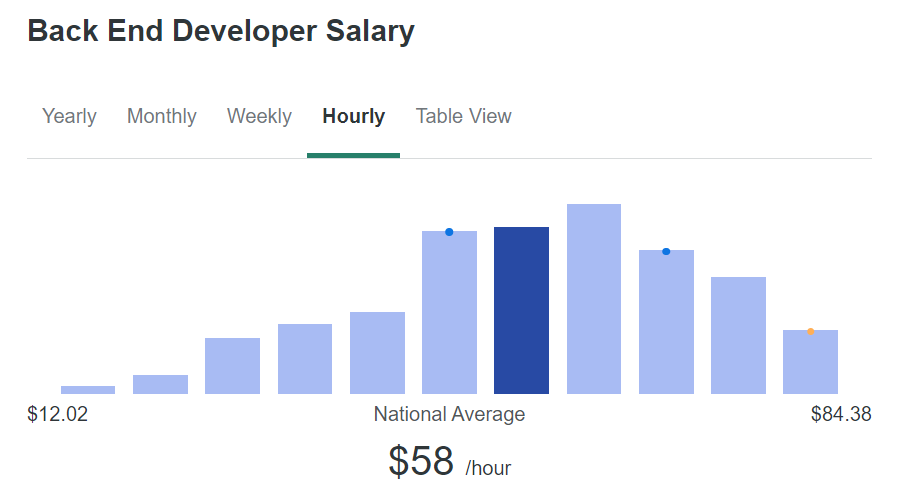Making Every Hour Count: The Ultimate Backend Developer Hourly Rate Guide
In the USA, backend developers earn an average of $57.73/hr, with potential earnings ranging from $47.36 to $68.27/hr. This wage spectrum is influenced by factors like the developer’s experience, with senior developers commanding higher rates than their junior or intermediate counterparts. Additionally, regional differences can further affect these rates.
Table of Contents
It is important to be aware of the current rates for the skill before you start to hire Backend developers for your project. Whether you’re a backend developer looking to understand your market value or an employer planning to hire backend expertise, this guide aims to offer a clear perspective on the current compensation trends in this crucial area of web development.
Navigating the Average Hourly Pay for Backend Developers
Across the four platforms, ZipRecruiter, Talent.com, Glassdoor, and Salary.com the rates for developers vary slightly. ZipRecruiter and Talent.com seem to offer closely matched rates for developers across all experience levels, with Talent.com slightly edging out for Senior Developers. Glassdoor tends to rate a tad higher for both Junior and Mid-Level Developers compared to the other platforms, but not by a significant margin. Salary.com, on the other hand, generally offers the lowest rates, especially noticeable for Senior Developers.
What Drives Backend Developers’ Hourly Earnings?
- Experience Level
A backend developer’s accumulated years of practice and expertise can significantly influence their rate. Those with more extensive experience generally command higher fees than beginners.
- Geographical Location
Rates can diverge based on the cost of living and the tech industry’s demand in a particular area. Developers in tech hubs or high-cost regions might charge more than those in other areas.
- Technical Proficiency
Backend development encompasses various languages, databases, and frameworks. Developers with proficiency in specialized or high-demand technologies often have higher rates.
- Project Complexity
The intricacy and requirements of a project can adjust the rate. Complex projects that demand advanced database architecture or integration challenges may have elevated rates.
- Education and Certifications
Although hands-on experience is paramount, having formal education or certifications in backend-related disciplines can marginally impact the developer’s hourly rate.
Where Backend Developers Command Top Hourly Rates
| Region | Average Hourly Rate (USD) |
|---|---|
| North America | $50 - $80 |
| South America | $20 - $40 |
| Western Europe | $40 - $70 |
| Eastern Europe | $25 - $50 |
| Australia | $50 - $80 |
| Asia | $15 - $40 |
| Africa | $15 - $35 |
Backend developer hourly rates exhibit noticeable variations based on the region. North America and Australia top the chart with the highest rates, closely paralleling the average rate in the USA. Western Europe follows suit, with Eastern Europe presenting more competitive rates. South America, Asia, and Africa generally offer the most economical rates, although there are wide disparities within these continents, especially Asia. These disparities are often reflective of the local cost of living, demand for tech skills, and the maturity of the tech ecosystem in these regions.
Statistics from talent.com suggest that even in the United States, the hourly rate obtained by a Backend developer varies according to the state. The highest salary is obtained by developers in Connecticut followed by developers in California, Massachusetts, Virginia, New York, Georgia, Maryland, Kansas, Texas, and North Carolina coming in tenth place.
Further, talent.com details that in the United States, the average hourly rate for a Backend developer is $57.69 per hour. Entry-level positions start at $46.92 per hour, while the most experienced workers can earn up to $75.00 per hour.
Backend Technologies and Their Impact on Hourly Earnings
| Backend Technology | Average Hourly Rate (USD) |
|---|---|
| Ruby on Rails | $70 - $140 |
| Laravel | $60 - $125 |
| Python | $65 - $130 |
| Django | $70 - $135 |
| Spring Boot | $75 - $145 |
| Node.js | $65 - $130 |
| Express.js | $60 - $125 |
| Flask | $65 - $130 |
| PHP | $50 - $110 |
| MongoDB | $70 - $140 |
Backend technologies like Spring Boot, Django, and MongoDB tend to command higher rates due to their dominant positions in enterprise, web applications, and database management, respectively. Ruby on Rails, once a go-to for startups, still maintains a solid rate because of its mature ecosystem. Node.js and Express.js, riding on the ubiquity of JavaScript, also have competitive rates, while PHP, despite being older, retains steady demand. Overall, rates align closely with the current market demand and the specific niche that each technology caters to in the software development landscape.
Conclusion
This blog post offers an insightful overview of the financial landscape for backend development professionals. It underscores the impact of experience, location, and project complexity on determining hourly rates. This guide is an essential resource for backend developers seeking to gauge their earning potential and for businesses looking to recruit backend talent. Overall, it reflects the significant role of backend development in the tech sector and outlines the current compensation trends, providing a valuable reference for those navigating the economic aspects of backend development.
You can check out our Backend Developer Annual Salary Guide to learn about the annual salary rates you can earn in the US and across the world. We bring you a complete Backend Developer Hiring Guide, along with the Backend Developer Job Description and Backend Interview Questions guide. which will help you in the process of hiring a Backend developer in 2025.
Table of Contents








